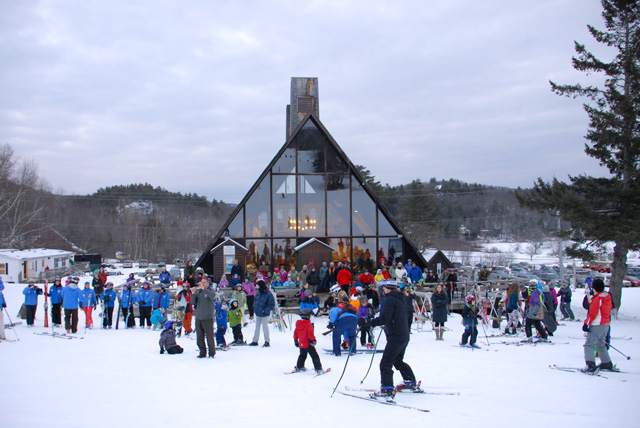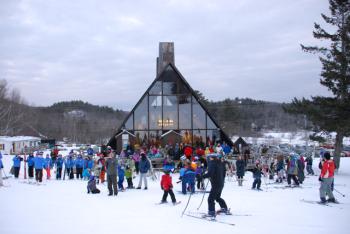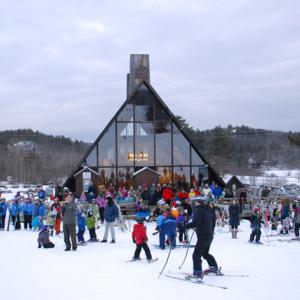Camden voters consider $2 million Snow Bowl bond, three zoning amendments
CAMDEN — Voters in Camden have four municipal pieces of business to tend to at the polls Nov. 5: three ordinance amendments and one proposed $2 million bond to support extensive upgrades at the Camden Snow Bowl.
Read the municipal ballot here.
Camden Snow Bowl
On Sept. 2, the Camden Select Board unanimously approved placing a $2 million bond to help fund lift and trail improvements, as well as new lodge construction, at the Camden Snow Bowl. Read about the project in depth: Snow Bowl ready to put $2 million bond before voters.
If approved, the $2 million would combine with $4.5 million in private donations and be spent at the year-round, town-owned Snow Bowl, with work beginning in 2014. The $6.5 million project has been in planning and fundraising phases since 2008, and proponents are now ready to advance it.
The language of the question reads as follows.
“Shall the Town:
(1) Approve a Capital Improvement Project to redevelop the facilities at Ragged Mountain, including all expenses reasonably related thereto;
(2) Accept donations in the approximate amount of Four Million Five Hundred Thousand Dollars ($4,500,000) from the Ragged Mountain Recreation Area Foundation and other sources, which donations are to be applied to the costs of the Project;
(3) Appropriate the sum of Two Million Dollars ($2,000,000) to meet the Town's share of the costs of the Project; and
(4) fund this appropriation by authorizing the Treasurer and Chair of the Select Board to issue general obligation securities of the Town of Camden, Maine, in an aggregate principal amount not to exceed Two Million Dollars ($2,000,000), including the discretion to fix the date(s), maturity(ies), interest rates, call(s) for redemption, denomination(s), form(s) and other details of said securities, and including execution and delivery of said securities on behalf of the Town, and to provide for the sale thereof?
NOTE: The estimated total cost of the project is Six Million Five Hundred Thousand Dollars ($6,500,000). The Town's share of the cost will be limited to the lesser of 30 percent of the actual cost of the Project or Two Million Dollars ($2,000,000). Town funds will be distributed by the Select Board in a manner which ensures that a minimum of seventy percent (70 percent) of the actual cost of the Project is funded by donations.”
So far, private fundraising has received $4.1 million in pledges.
What economists say about the Snow Bowl
On Oct. 15, the Camden Select Board heard a synopsis of an economic impact study prepared for the Camden Snow Bowl last summer. Jim Damicis, of Camoin Associates, a Saratoga Springs-based economic planning consultant company, delivered a presentation that had been commissioned by the nonprofit Ragged Mountain Recreation Area Foundation to conduct what Town Manager Patricia Finnigan described as a “data-driven research to show exactly what it [the Snow Bowl] means for our community.”
Specifically, the study estimates the Snow Bowl’s economic effect on sales, jobs and wages in the local region.
Read the Camden Snow Bowl Impact Study in entirety here.
The same company is doing a similar analysis of the Camden Opera House, she said.
Damicis told the board in mid-October, “[The Snow Bowl] is not one of your West Coast resorts or Sugarloaf but it is important.”
He said people visiting the Snow Bowl to ski and snowboard are traveling from farther away (30 miles and more), and because so, they are bringing more money to the area.
“The farther you come from, the greater the economic impact,” said Damicis. “A lot of money is coming from 30 miles away or more.”
The consultants data research depended on zip codes of all season pass holders, the annual use of the Snow Bowl from 2006-2013, and annual payroll.
They also estimated average visitation spending of typical locals and non-locals going to the Snow Bowl. Finally, they calculated the direct jobs and economic activity resulting from projected new annual visitors. Using Economic Modeling Specialists software and multiplier effect formulas of the U.S. Department of Agriculture, they figured the following:
From 2008 to 2013, the average annual number of visits to the Camden Snow Bowl was 29,849. The annual number fluctuated, given the varying snow pack amounts. Of them, approximately 16 percent were Camden residents; 24 percent, local (within a 30-minute drive-time); and 59 percent are from the non-local area (farther away from a 30-minute drive-time).
Of season pass holders, 31 percent were from Camden; 34 percent, local; and 34 percent were from the non-local area.
Of the visitors to the Snow Bowl who did not hold season passes, 9 percent were from Camden; 19 percent, local; and 72 percent were non-local.
Visitor spending
Using that data, the economists then calculated visitor spending by category (food and drink, transportation, recreation and miscellaneous, souvenirs):
Locals are spending approximately $64 per visit, per person, for a season total of $559,787.
Non-locals are spending $132 per trip, per person, for a total of $1.95 million per season.
Given that the Snow Bowl has no local competition, and is a unique function unto itself, the consultants then calculated that local residents would spend their winter recreation dollars elsewhere if the Snow Bowl did not exist.
“If the Snow Bowl were to cease operations, those local and non-local users would cease spending those funds in the local economy and the resident users would take their winter recreation spending money outside of town,” the study said. Those dollars are estimated at $146,020.
Going another step, the consultants figured that with local spending estimated at $559,787, and non-local spending at $1.95 million, and with another $146,020 added for the formula, the annual direct spending generated by the Snow Bowl is $2.1 million.
“The impact of the Snow Bowl on the Town of Camden comes primarily from user spending, both onsite spending on lift tickets supporting operation costs and offsite spending on food, drink, gas, etc.,” the study said.
Taking that sales figure of $2.1 million, the consultants then estimated the spin-off economic effect, incorporating what employees spend locally to live and work in the area.
“The “$2.1 million in direct spending (sales) creates 50 direct jobs and $1 million direct earnings,” the report said.
The study’s executive summary said: “It is important to note here that the direct spending figure includes spending on recreation, such as Snow Bowl lift tickets, which funds the operation of the mountain, including maintenance and employees.”
According to the study, there are 73 employees at the Snow Bowl, most of them working seasonally and part-time. Therefore, the consultants estimated there are 50 “direct” jobs associated with the Snow Bowl, with annual earnings of $1 million.
“As those dollars continue to circulate, additional jobs and business activity are created,” the study concluded. “This effect is captured in the indirect impacts. The $2.1 million in direct sales results in a total $3.7 million in sales, 62 new jobs and $1.4 million in earnings in and around Camden.”
Snow Bowl improvement goals
In 2008, Camden voters approved a non-binding measure that positioned support for borrowing up to $2 million for Ragged Mountain Recreation Area improvements, if matched by a minimum of $4.5 million raised via private money. Following that vote, project proponents commenced soliciting contributions, as well as holding public fundraisers. The committee is now reaching the $4 million mark.
The matching funds — $2 million of town funds and $4.5 million in donations — would be expended together, not one before the other, and expenditures are planned to match the cash flow of donations over a two-year period.
That cash flow is also contingent on timing the financing with the Maine Municipal Bond Bank, which issues bonds twice a year, in the spring and the fall. In order to get on next spring’s bond list, the town must vote, and approve the measure, this November.
The cost of borrowing $2 million to the taxpayers could average $110,000 in annual interest payments for 30 years
The capital improvement project at Ragged Mountain entails making mountainside improvements in 2014 and constructing a new lodge in 2015. The intent is to “provide the capacity to accommodate up to 600 skiers per day with adequate parking, lodge space, uphill lift capacity, and ski terrain serviced by snowmaking and enhance year-round trail use for hikers and mountain biking,” according to the updated plan.
In June, Camden taxpayers approved expending $15,000 on the municipally-run Snow Bowl to help keep it in operation. The Ragged Mountain budget this year is $700,828.
The mountain has been supported by the town in varying degrees since the town assumed ownership of its real estate and operations in 1983. In 1990-91, Camden voters approved funding the Snow Bowl with $149,000 of their tax dollars; in 2009-2010, it was $55,000. Last year, and following several years of good snowfall, the town contributed zero dollars.
The Redevelopment Committee has built a detailed finance and budget analysis of the Ragged Mountain Recreation Area through 2016, incorporating the entire mountain upgrade. Aside from debt obligation, the projected budget includes no town matching funds in 2015 and 2016. Instead, the budget anticipates additional revenue will derive from the increased numbers of daily and season ski tickets, ski school enrollment and new lodge rentals.
What’s going to change at the mountain?
Improvements include repurposing the existing double-chair lift, removing both T-bars and installing a used triple-chair lift to the top of the mountain, near the same path of the existing Big-T. Design and engineering for this aspect of the overhaul is a large component of the entire project.
The plan also entails keeping the existing lodge for race training and events, and building a new 8,500-square-foot lodge with seating for 200 and food service.
Snowmaking is to be be expanded from 40 percent to over 80 percent coverage, including the improved novice area and the top of the mountain.
“All together, these improvements will provide a comfortable carrying capacity of 600 visitors and a peak capacity of 1,000 visitors with adequate parking, lodge space and ski/snowboard terrain, generating an average of 35,000 skier visits annually,” the updated plan said.
“The redevelopment project is envisioned to renovate or replace aging facilities and to expand the services and programs offered at the Ragged Mountain Recreation area during both skiing and non-skiing months,” the update said. “The redevelopment project will not, and should not, fundamentally change the family appeal of the recreation area and its affordable access to outdoor recreation activities. The committees and individuals involved in the project thus far feel strongly that now is the time to redevelop the facilities at Ragged Mountain in order for the community to enjoy the next 30 to 40 years of local, affordable and healthy outdoor recreation.”
Components of the project carry estimated price tags:
1) Purchase of the triple-seat chairlift, reconfiguration of existing lift, removal of T-bars: $1 million.
2) Improving snowmaking and equipment, trailwork, power upgrade and distribution: $2.5 million.
3) New lodge: $2 million.
4) Architecture, design, engineering, consultants: $1 million.
“The pump is there, and pipes have to go in,” he said. “Compressors we can lease. Companies bring them in November and pick them up in the spring. Operationally, it’s more expensive but we avoid the capital investment.”
“You all have seen Fitzy [Snow Bowl Facilities Manager William Fitzcharles] and his crew dragging the hoses around the mountain,” said Knowlton. “At most large mountains those are fixed and part of the permanent installation.”
Accessory Storage Containers
The proposed zoning amendment defines those structures as Accessory Storage Containers. Such structures are roofed containers “placed outdoors and used for the storage of goods, materials or merchandise, which are utilized in connection with a lawful principal or accessory use of the lot.”
Read the proposed amendment here.
The term includes, but is not limited to, box cars, semi-trailers, roll-off containers, slide-off containers, railroad cars and piggy-back containers. The term does not include a garage or barn accessory to a dwelling.
“An accessory storage container is considered a structure and must meet any required setbacks from the property lines,” the proposed amendment said.
The proposed zoning amendment defines those structures as Accessory Storage Containers. Such structures are roofed containers “placed outdoors and used for the storage of goods, materials or merchandise, which are utilized in connection with a lawful principal or accessory use of the lot.”
The proposed zoning amendment says that containers placed on a lot for a period of 60 days prior to November ??? [sic] 2013 may remain until replaced, moved or upgraded, unless they become unsafe or a hazard.
Accessory storage containers ordinance language resulted in two Select Board members, John French and Leonard Lookner, voting against putting the measure on the November ballot. They said that not enough is being done to rectify the appearance of existing storage containers.
At issue are several instances in town where businesses are apparently using containers, like box cars, for storage.
Both Lookner and French had disagreed earlier this fall with their Select Board colleagues on the effectiveness of the amendment.
“There is no vendetta against any business, but we were told last year [the June zoning amendment] would give businesses the opportunity to get rid of storage containers,” said Lookner. “Now we being told those containers are legitimate, that they are structures.”
French agreed with Lookner, and said that when a zoning amendment was approved last year, the resulting expansion would help to do away with the storage units.
The proposed zoning amendment, “doesn’t do anything for trailers in place now,” he said.
Other Select Board members Don White, Martin Cates and Jim Heard countered that the proposed amendment “puts teeth in the ordinance” governing such structures, and provides the code enforcement officer with more clout to regulate accessory containers.
In November 2012, the town voted to amend the zoning ordinance, loosening rules in some parts of Camden to allow property owners the option of going before the Zoning Board of Appeals, and possibly the Planning Board (if a site plan review is required for larger expansions) for permission to expand a building or parking footprint on lot.
It was billed as a venue to allow business owners, approximately 11 of them, to improve business.
Harbor ordinance amendments
The proposed amendments to the harbor and waterways ordinance also resulted in a divided vote to place it on the November ballot, this time 4 to 1, with John French opposing the motion to include them on the Nov. 5 ballot. French specifically disagreed with a proposed mooring and float waiting list process.
The amendments are mostly housekeeping in nature, as well as asking voters to approve expanding the waiting list to include a section for “volunteers,” those who have had a mooring or float permit, but for one reason or another, no longer have a boat in the water, or other such circumstances.
The amendment says that the name of the permittee, referred to as “volunteer,” will “be entitled to priority ranking on that waiting list. As permits become available they shall be first offered to those volunteers who shall have been so ranked in reverse order of listing such that the names of the volunteers who have remained continuously on the list for the longest period of time as measured from the dated added to the list shall have right of first refusal with respect to applying for any such available permit.”
See proposed harbor ordinance changes here.
French disagreed with altering the current mooring list methodology, which is organized chronologically, according to when an individual adds his or her name to the waiting list.
Harbor committee member Sandy Welte explained to the Select Board Sept. 3 that the: “goal is to have impact on what is now a stagnated list, yo open up the use of the harbor to more folks.”
The amendments include 17 other changes, many of them housekeeping and refining definitions, which “makes our job a lot easier as an appeals board,” said Harbor Committee Chairman Gene McKeever, at the Sept. 3 meeting. “We would not want Superior Court to look at a document that is flawed.”
The problem with the existing waiting list is that “it has tendency to drag on and on and on,” he said. “The working group has come up with logical way to deal with people who are hanging on in order to just hang on.”
French suggested monitoring the moorings more, “and moving people along.”
“This is a good way to move people along,” said McKeever.
French suggested distributing permit stickers.
“If there’s not a sticker, why is the boat there?” he said.
“That’s playing cop,” said McKeever. “We are trying to make it work. No matter which way you go, it’s a plus. We are just trying to make a to move it a little faster.”
French said he agreed with the other amendments contained in the harbor ordinance, just opposed the expansion of the waiting list practice.
Changes to River Business District
The last amendment to be approved for the November ballot concerns loosening zoning regulations in the River Business District to encourage multi-use of space to accommodate residential and business enterprise. The amendment proposal calls for expanding use to include “single family, two-family and multi-family dwellings, except that no residential use shall occur on a floor at street level without an equivalent area of allowed commercial, professional services, industrial, or utility uses as defined below, in a building at street level on the same lot of record.”
The town’s land use ordinance says the purpose of the River Business District is to provide for the maintenance, development and redevelopment of lands and buildings in river-oriented locations that have historically been used for economic activity.
Read the proposed changes to the River Business District here.
Editorial Director Lynda Clancy can be reached at lyndaclancy@penbaypilot.com; 207-706-6657.
Event Date
Address
United States

























